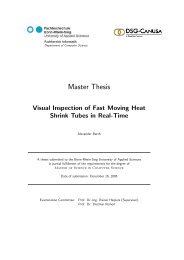Master Thesis - Hochschule Bonn-Rhein-Sieg
Master Thesis - Hochschule Bonn-Rhein-Sieg
Master Thesis - Hochschule Bonn-Rhein-Sieg
Create successful ePaper yourself
Turn your PDF publications into a flip-book with our unique Google optimized e-Paper software.
7. Conclusion and Outlook <strong>Master</strong> <strong>Thesis</strong> Björn Ostermann page 117 of 126<br />
- The increase in the safety distance, described in chapter 5.5.5, can be made dynamic, dependant<br />
on several factors:<br />
o The size of the robot’s current tool<br />
o The speed of the robot and of dynamic objects<br />
o The direction of the movement of robot and dynamic objects<br />
o The robot’s maximal physical dimension at that distance<br />
- The problem of the robot’s juddering in direct drive mode (see chapter 7.1) needs either to be<br />
fixed by the robot’s manufacturer or a workaround using the point to point mode needs to be<br />
programmed.<br />
- For the application in praxis, the safety controller of the robot would have to be included in the<br />
process of object avoidance.<br />
The basic function, necessary for the safety of the desired approach of a flexible fence, is already<br />
implemented by the safety trips of REIS [48]. They act as a virtual wall, through which the robot<br />
is not allowed to move. This could be used to secure a safe execution of the commands of the PC.<br />
Today those safety trips, in accordance with EN 10218-1 [70], can not be changed during the<br />
runtime of the control but only during its start-up phase, thus building a rigid fence.<br />
- The application of human models to the detected dynamic intrusions would allow the algorithms<br />
to predict occlusion of the workspace in the future. This would enable the path planning<br />
algorithm to compute more optimal trajectories. The proximity monitoring, which needs to be<br />
safe, can not profit from predictions.<br />
- Previous work discussed the usage of splines to smoothen the robot’s trajectory. Field tests in this<br />
work showed that those splines were not helpful, due to the slow movement of the robot and the<br />
problems with a smooth driving (juddering – see above). Later versions of this project should<br />
study this subject further, after the removal of the juddering.














